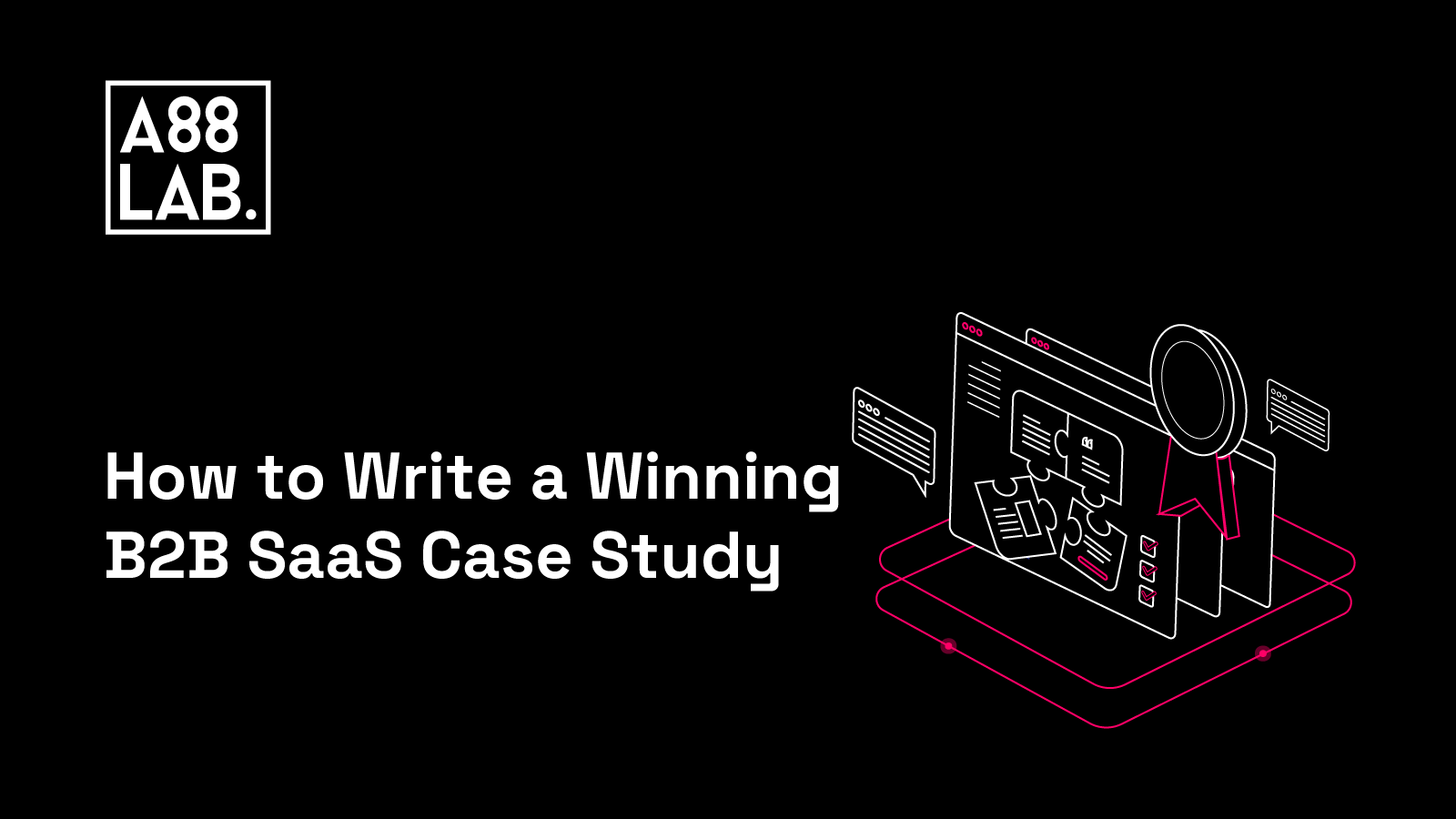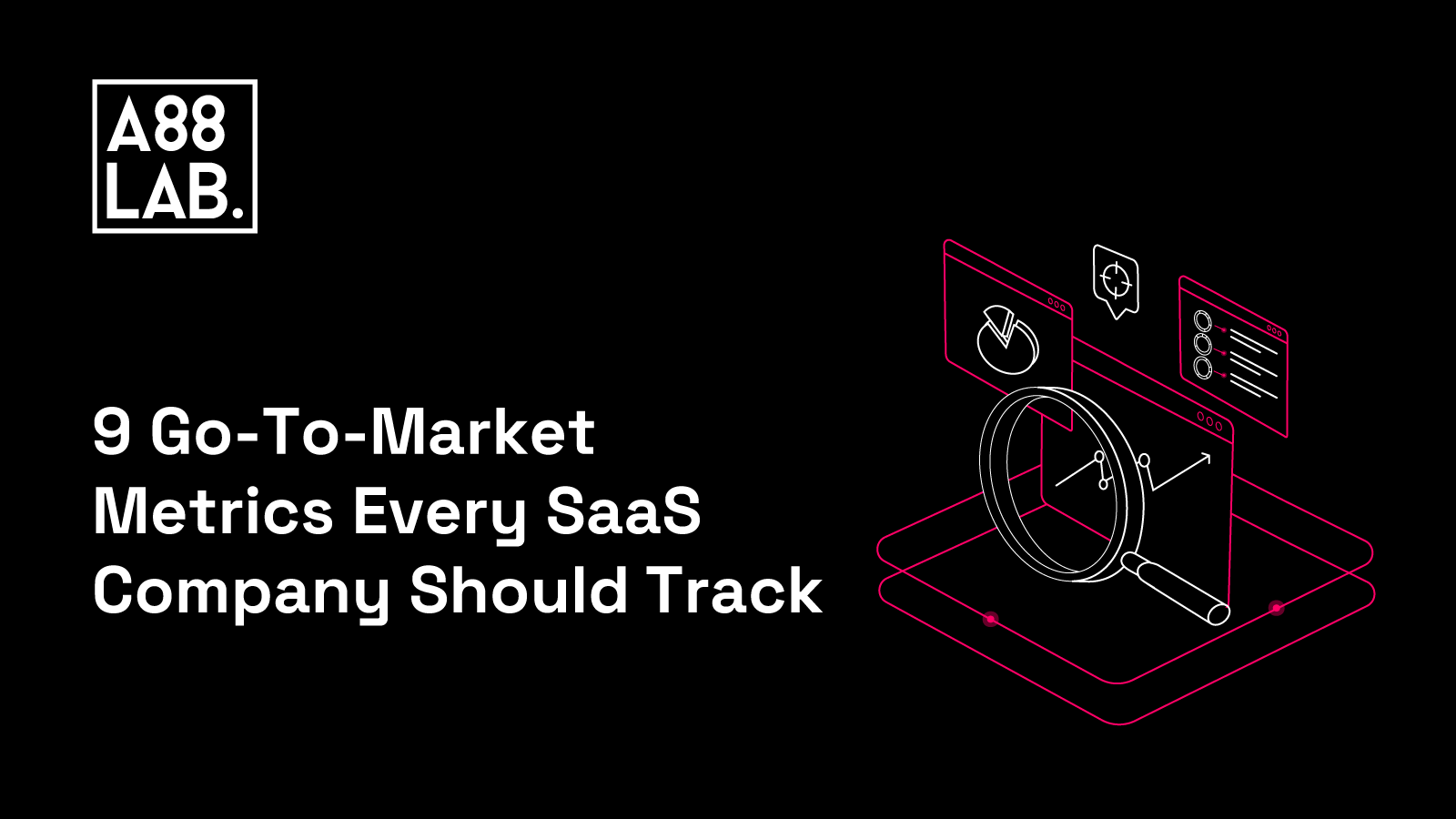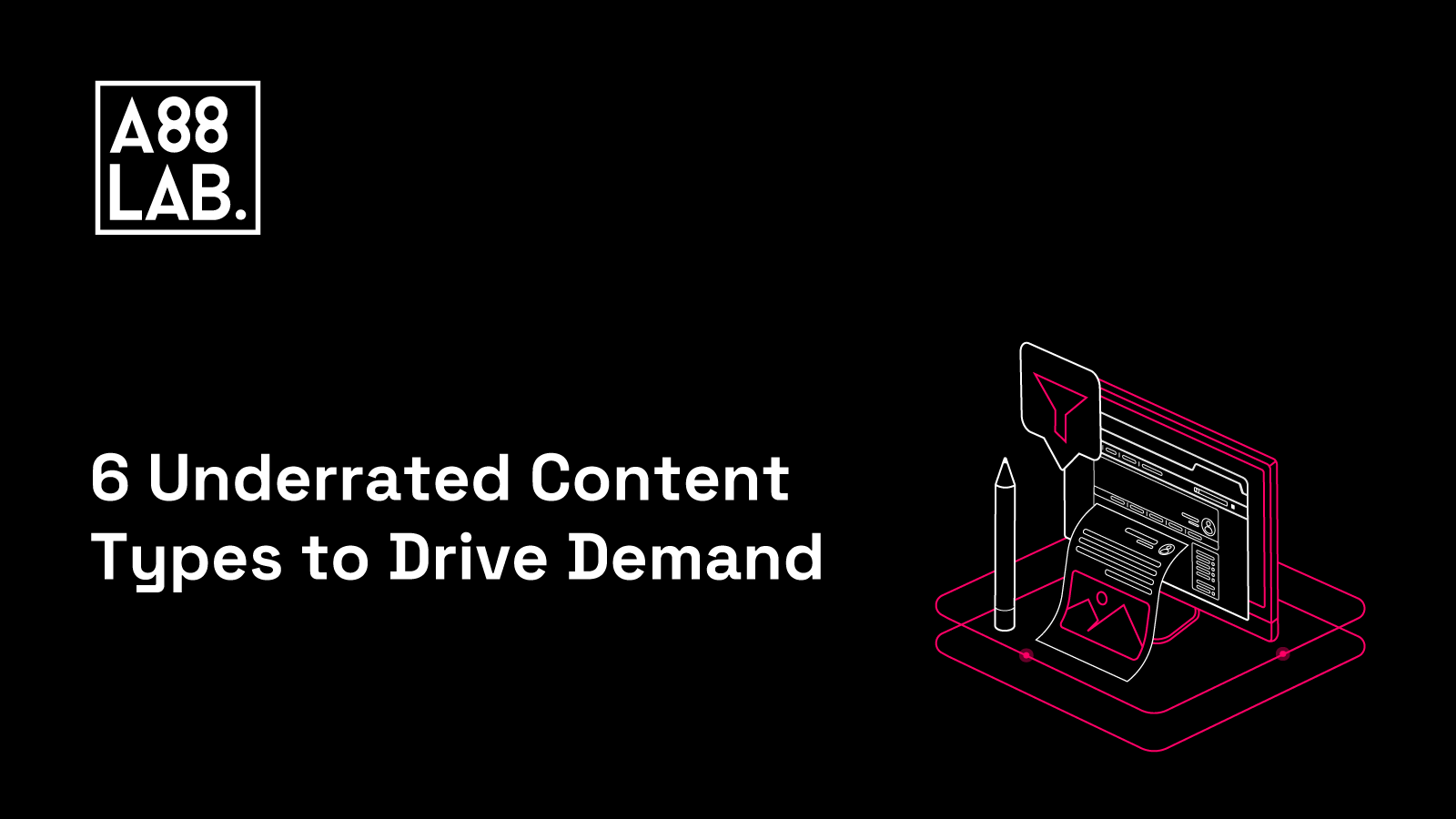Case studies are highly valued among SaaS buyers.
Why?! THEY BUILD TRUST!
Case studies show that your product really matters, that it has industry applications, and most importantly, it shows results.
While websites, blogs, social media, and other types of content pieces are also important, case studies take things to the next level.
Knowing how to write a (good) case study is one of the most important skills every B2B SaaS marketer needs to have, considering case studies are the number #1 marketing tactic that increases sales compared to others.
However, writing a successful B2B SaaS Case Study can be challenging. We’ve done it many times, and trust us, we know. That’s why this blog post will cover everything (that we believe) you need to know to write a successful B2B SaaS case study that converts.
Let’s dive in👇
Why Are Case Studies Important for B2B SaaS Businesses?
Case studies do one thing pretty well, show real and tangible results. While marketing explains what will happen, case studies show what actually happened.
Here are several reasons why case studies should be a must in your content strategy:
- Impact decision making: 42% of B2B buyers find case studies incredibly helpful in both the mid and late stages of their buyer journey, and for almost 80% of B2B buyers, case studies are an integral part of their buyer research process.
- Drive engagement and sales: Case studies are customer success stories that demonstrate the effectiveness of a business's offerings. By showcasing these success stories, you build trust among your potential customers and help them understand how your offerings can benefit them too. This can lead to higher engagement and, ultimately, to higher conversion.
- Custom-fit: By tailoring your case studies to speak directly to your ideal customers, you effectively engage with them and make your message more resonating. This approach builds stronger relationships with your target audience as it demonstrates your understanding of their needs and challenges.
The end goal of your case study is to connect with those who are reading it on a more personal level. They should remind their target audience that behind every decision they make, there are real people with real challenges and desires. This human-to-human (H2H) approach transforms a standard case study into a relatable one with an engaging story that resonates with B2B buyers.
Related reading: Demand Generation Guide for B2B SaaS Companies
8-Step Process for Crafting a Compelling Case Study
Now that we covered why case studies should be an integral part of your overall marketing strategy, let's take a look at the steps you need to take to build a successful one:
1. Define the Purpose of your Case Study
When it comes to creating a case study for your SaaS company, the first step is to establish the purpose of the case study. You need to determine why you are writing it and what you hope to achieve from it. Once you have a clear objective, you can start planning the rest in a way that resonates with your target audience.
Some of the common reasons for writing a case study in the SaaS industry can be:
- Showcasing the product's features and benefits
- Demonstrating its usability
- Highlighting customer success stories
- Attracting new customers and retaining existing ones
- Building trust with potential buyers.
Understanding the primary reason behind your case study will serve as the foundation for your writing style, and it will dictate the way you present your brand. A well-crafted case study can help to generate website traffic, nurture sales leads, and educate the target audience on your product.
2. Gather Background Information
One key step when crafting your case study is gathering background information about your clients, their industry, and the problem you are trying to solve. To get the best information, interview your clients.
Another good source of information is your sales team. They can provide insights into the customer's pain points from their sales calls and demo presentations. It is important to have an ideal reader in mind while doing research so that you can personalize the case study.
As a SaaS company, you are likely targeting decision-makers from different industries. So, keep that in mind while writing your case study. The goal is to make the reading as relevant to the target audience as possible.
To make it easier for your readers, you can provide several filtering options on your website, just like Gong does.

This allows them to find case studies that are most relevant to their industry. Understanding the industry inside and out is crucial to communicating more effectively with each reader.
3. Hook the Readers With a Killer Headline
Your case study headline is the first thing your readers will see. According to Copyblogger, 8 out of 10 people read the headline, but only 2 out of 10 continue reading the content. Therefore, make sure that it’s catchy and engaging enough to draw people's attention but not overloaded with too much information. The goal is to tempt your readers to click through and explore more.
A good case study headline answers common questions that go through every reader’s head, like:
- Is this relevant to me?
- What will I learn?
- How will this help my business?
So, here are three elements to keep in mind when picking your headline:
Firstly, make sure to include your client's company name to show your case study is a real-life example of how your solutions can help someone. By doing so, you'll help your potential customers connect with your case study on a more personal level, making it more relatable and trustworthy.
Secondly, mention the specific product or service your customer used in your headline. Doing so gives readers an idea of what to expect from your specific SaaS product and helps them determine whether that product would be relevant to their needs. Moreover, it will also make your headline more attractive to the readers.
Lastly, highlight a statistic that reflects the amazing results your customer achieved by working with you. This is a great way to showcase your service's effectiveness and demonstrate how it can help others achieve the same or even better results.
Drifts’ case study example of a catchy headline:

4. Describe the Challenge
Once you complete the first three steps, you can proceed with writing the body of your case study. Every successful B2B SaaS case study begins by clearly describing the challenges faced by the customer before discovering your solution. This moment is critical in setting the stage for the transformation that follows, so it's important to articulate the problems faced by your client. This puts the customer at the forefront, ensuring that their story remains genuine and relatable.
To effectively outline the challenge, you need to provide enough information while keeping the focus on the customer. Avoid getting too detailed, as this may overshadow the authenticity of the case study. Instead, aim for concise yet impactful descriptions that resonate with your target audience.
Consider answering important questions such as:
- What hurdles did the customer face?
- What were the consequences of these problems?
Make the challenge relevant to your target audience by using language they can relate to and including your customer’s words.
By presenting the challenge through your customer's experiences, you establish a genuine connection with your audience, emphasizing the importance of their journey and the value of your solution.
Example of Gong highlighting the challenges and outcomes at the beginning of their case study:
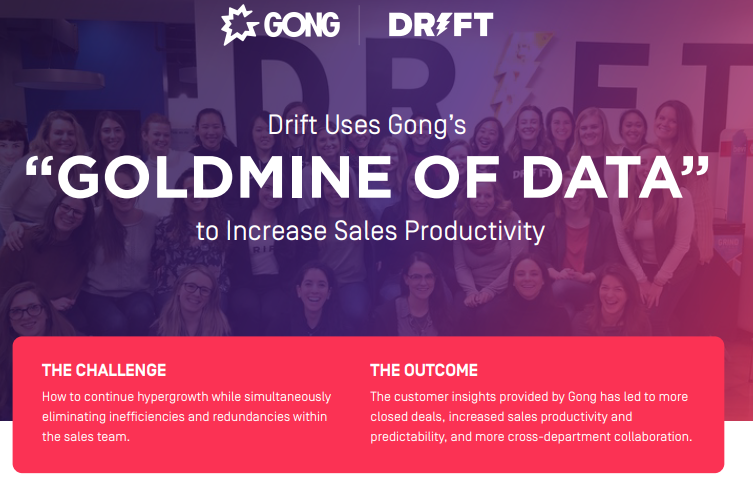
5. Highlight the Solution
As the narrative unfolds, start to seamlessly integrate yourself into the customer's journey, showcasing how your solution addresses their challenges effectively.
Start by briefly introducing your product or service, outlining its key features and unique selling points. Emphasize how these attributes directly align with the specific problems faced by the customer, strengthening the relevance of your solution.
Remember to maintain focus by discussing only the features directly relevant to the story's theme, avoiding unnecessary distractions. By linking these features to the challenges commonly faced by your target audience, you ensure that readers grasp the practical importance of your solution.
Next, talk about the benefits your client experienced from your solution. Mention the specific teams or employees that saw improvements in their workflows or productivity thanks to you. Detail if there were any premium features or add-ons used.
By explaining how your solution delivered tangible results and exceeded customer expectations, you instill confidence in potential clients who may have experienced poor customer service in the past.
6. Have a Complaining Narrative
The narrative of your B2B SaaS case study needs to be both engaging and easy to follow. Essentially, think of it as telling a story that has a clear and logical progression.
To get started, set the stage by outlining the problem your client faced. Share the challenges, pain points, and obstacles they encountered. This helps the reader relate and understand why your solution was needed.
Next, introduce your SaaS product or service your client used as the solution to these challenges. Show how your offering addressed the specific needs of the client and provided a practicable solution to their problems. This is where you can highlight the unique features or capabilities of your product that were instrumental in resolving the issue.
As you guide the reader through each step of the process, focus on painting a vivid picture of the transformation that took place. Share how your solution was implemented, detailing any hurdles that were overcome and the strategies employed to achieve success. This adds depth to the study and reinforces its credibility.
Finally, wrap up the story with the outcome achieved by your client. Showcase the tangible results, whether it be increased efficiency, cost savings, revenue growth, or any other measurable impact. This serves as the conclusion of your narrative, demonstrating the real-world value and benefits of your SaaS solution.
By crafting a compelling narrative that flows seamlessly from problem to solution to the outcome, you keep the reader engaged and make the case study more relatable and easier to follow. This storytelling approach not only enhances the readability of your content but also reinforces the persuasive power of your B2B SaaS case study.
7. Backup the Outcomes With Data
You can’t build a winning case study without showing tangible metrics. Implementing real-world customer data into your study will help you validate the story and provide factual evidence of the impact your solution has had.
Up to 76% of SaaS marketers include key metrics in their case studies. Why? Because specifics like time saved and revenue increased speak volumes.
To make sure your case study resonates with readers, focus on metrics that are directly related to the client's success story. These metrics should be seamlessly integrated into the narrative, illustrating how they translated into real benefits for the client. For example, a 30% increase in revenue could be contextualized within the narrative to highlight its role in enabling business expansion or investment in new areas.
Visual aids such as graphs, charts, and infographics are also helpful in enhancing the presentation of data, making complex information more digestible and memorable for the audience.
All effective case studies have a happy ending. Explain how your customer is better off than before using your product, with real data to prove your point.
8. Guide the Next Steps
As you wrap up your case study, emphasize the effectiveness of your solution and leave the readers with a convincing call to action. Recap the outcomes achieved by the featured client, highlighting the transformational journey from the problem to the solution. Moreover, provides insights into the client's future trajectory now that the challenges have been addressed, giving the readers a peek into the continued success achieved with the help of your product or service.
Make the closing statement more personal by including clients' testimonials to validate the genuineness of the story. By allowing the customer to reflect on how your product or service impacted their business and express their satisfaction, you reinforce the credibility of the case study and motivate readers to take action.
3 Great B2B SaaS Case Study Examples
SIf you are finding the steps mentioned difficult to understand and are looking for some practical examples of how other SaaS companies have crafted their case studies, we've got you covered.
1. Plaid
Plaid is a fintech company that provides a secure platform for users to connect their bank details to online applications. Their compelling case studies address the critical concern of financial security and showcase how their clients' experiences are transformed.
For instance, Plaid's case study of Betterment highlights the client's goal of onboarding new users and driving engagement. The study provides company details and outlines a singular problem and its solution.
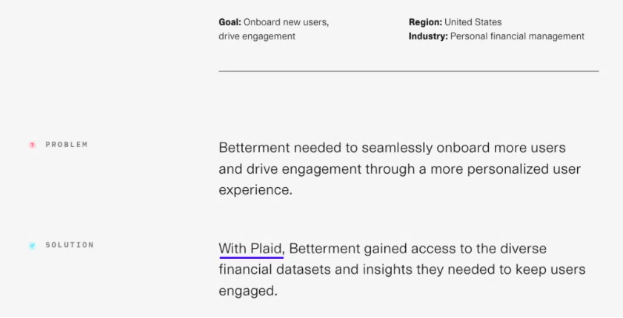
Plaid keeps Betterment's desired result front and center and offers a positive outlook on the SaaS business. They provide a clear and concise explanation of how they helped Betterment in a brief version of a ten-page white paper. Furthermore, the case study lists various benefits that Plaid provided to Betterment.
Plaid's subtle yet effective product integration and well-organized process make it easy for customers facing similar challenges to envision the solution.
2. Playvox
B2B case studies should be written in a language that the ICPs can easily understand. Playvox is a customer service platform that assists businesses in streamlining their operations. In this industry-specific case study, Playvox addresses the unique challenges facing Sweaty Betty, a company in a niche industry, such as the assessment times for accounts of retail and online shops.
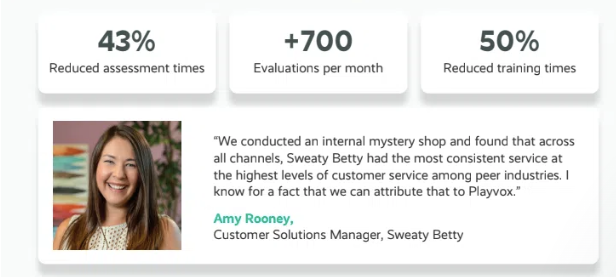
The case study starts by presenting the results achieved for Sweaty Betty. Then follows a simple yet impactful format, highlighting the challenges faced, the solutions implemented, and the results obtained. Instead of listing solutions in bullet points, Playvox uses customer voice to showcase Sweaty Betty's transformation.
This formatting approach is effective because Playvox does not need to boast about the platform's usefulness. Sweaty Betty is already doing it for them.
3. CoSchedule
CoSchedule is a leading software as a service (SaaS) provider in the social media space. This outcome-led case study demonstrates why CoSchedule is so effective at capturing the market.
The study begins with a headline that emphasizes the results achieved, capturing the interest of readers who are looking for similar outcomes. The case study is straightforward and well-written, with catchy headlines that hold the reader's attention. Results are presented through graphs, quotes, and visuals as the reader scrolls through the study.
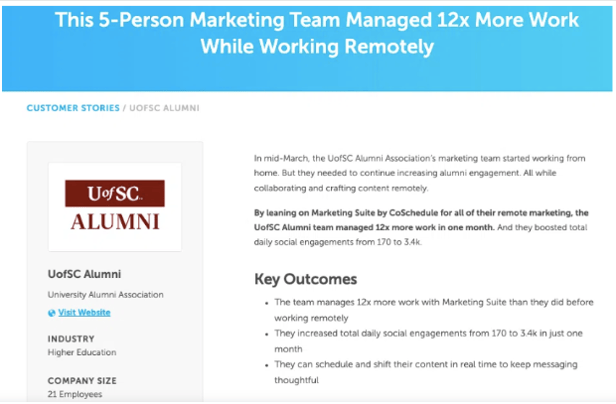
Finally, the study concludes with a quote from the customer, which echoes the outcome stated in the headline. Leading remote teams presents challenges for many organizations, and CoSchedule makes it easy for these teams to manage their operations. The case study clearly demonstrates the effectiveness of CoSchedule in this area.
Conclusion
Nailing how to write a winning B2B SaaS case study can be time-consuming, but it's a powerful way to demonstrate to potential customers that your product is the best solution to their problems.
By showcasing real-life examples of your product, you build trust in ways that other types of content cannot. This establishes your reputation and increases the likelihood of buyers converting. To create engaging and results-driven case studies that will help your business grow, it's important to maintain strong customer relationships, apply relevant market insights, seek inspiration from other brands, and follow the processes outlined in this blog post.
.png)
